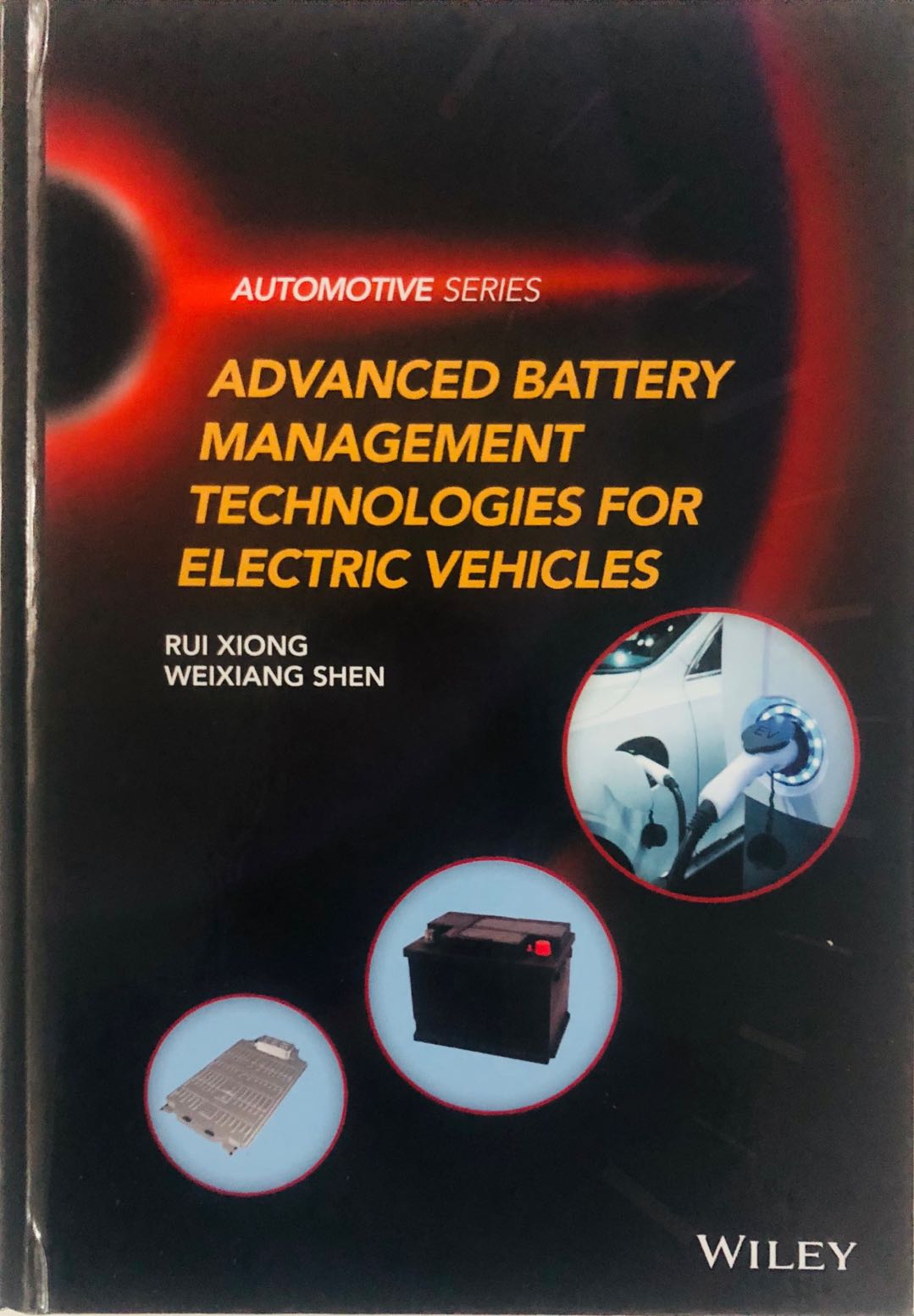 |
专著简介:This book introduces key battery management technologies and BMS. The purpose of these advanced technologies is to regulate the operation of the battery system within the allowable voltage, current and temperature range, and to estimate the optimal battery state of the electric vehicle. 主要内容如下: The first chapter introduces the basic knowledge of electric vehicle and the requirements for battery system of electric vehicle, and introduces the structure and function of BMS. Chapter 2 introduces the classification of battery modeling technology. Based on the equivalent circuit model, the off-line parameter identification method and on-line parameter identification method are introduced, and the application of each method is illustrated by examples. In Chapter 3-5, state of charge estimation, health state estimation and actual power state estimation are introduced respectively. Matlab code and Simulink model are used in the case study to implement these estimation methods and provide them to users. Chapter 6 reviews the different charging methods. Then, the latest development of charging method is introduced from two aspects. Chapter 7 introduces several battery balancing technologies, including battery classification, battery passive balancing and battery active balancing. Then, this chapter focuses on the active balance of battery. The eighth chapter introduces the basic function and structure of the battery management system. In addition, key insights for future generations of BMS are discussed, including self heating and safety management, as well as the application of cloud computing and big data in health state estimation and battery life prediction. |
专著资源分享
1. 模型:电池等效模型(Thevenin model.zip, 46.7kB);电化学模型(Electrochemical model.zip, 54.2kB);分数阶模型(Fractional order model.zip, 244kB);
2. SOX算法:EKF-SOC算法模型(program01_EKF.zip, 162kB);SOH算法模型(SOH.zip, 56.9kB);SOP算法模型(SOP.zip, 2.19MB);
3. 优化充电算法(optimal_charge.zip, 2.56kB);
4. 寿命预测模型(runBoxCox.zip, 3.45kB);
5. 测试数据:电池单体数据,电池组数据,实车运行数据 (点击查看)
6. 试读: 部分章节.pdf
部分章节.pdf
完整出版信息:Xiong R, Shen W. Advanced battery management technologies for electric vehicles[M]. John Wiley & Sons, 2019. (Wiley出版社)
相关参考论文
1. R. Xiong, S. Ma, H. Li, F. Sun and J.Li, “Towards a Safer Battery Management System: A Critical Review on Diagnosis and Prognosis of Battery Short Circuit”, iScience, vol. 23, no. 4, pp. 101010, April 2020. (下载链接)
2. R. Xiong, Q. Yu, W. Shen, C.Lin and F. Sun, "A Sensor Fault Diagnosis Method for a Lithium-Ion Battery Pack in Electric Vehicles", IEEE Transactions on Power Electronics, 2019, vol. 34, no. 10, pp. 9709-9718, OCT 2019. (下载链接)
3. R. Xiong, Y. Zhang, H. He, X. Zhou, Michael Pecht, “A double-scale, particle-filtering, energy state prediction algorithm for lithium-ion batteries,” IEEE Transactions on Industrial Electronics, vol.65, no.2, pp.1526-1538, Feb 2018. (下载链接)
4. R. Xiong, JP Tian, H Mu, C. Wang, “A systematic model-based degradation behavior recognition and health monitor method of lithium-ion batteries,” Appl Energy, vol. 207, pp. 367-378, DEC 2017. (下载链接)
5. R. Xiong, Q.Q Yu, LY Wang, C Lin, “A novel method to obtain the open circuit voltage for the state of charge of lithium ion batteries in electric vehicles by using H infinity filter,” Appl Energy, vol. 207, pp. 341-348, DEC 2017. (下载链接)
6. F. Sun; R. Xiong and H. He, “Estimation of state-of-charge and state-of-power capability of lithium-ion battery considering varying health conditions,” J. Power Sources, vol.259, pp.166–176, Aug. 2014. (下载链接)
7. R. Xiong; F. Sun; X. Gong and C. Gao, “A data-driven based adaptive state of charge estimator of lithium-ion polymer battery used in electric vehicles,” Appl Energy, vol. 113, pp. 1421–1433, Jan. 2014. (下载链接)
8. R. Xiong; F. Sun; Z. Chen and H. He, “A data-driven multi-scale extended Kalman filtering based parameter and state estimation approach of lithium-ion polymer battery in electric vehicles,” Appl Energy, vol. 113, pp. 463-476, Jan. 2014. (下载链接)
9. R. Xiong; F. Sun; H. He and T. Nguyen, “A data-driven adaptive state of charge and power capability joint estimator of lithium-ion polymer battery used in electric vehicles,” Energy, vol. 63, pp. 295–308, Dec. 2013. (下载链接)
10. R. Xiong; F. Sun; X. Gong and H. He, “Adaptive state of charge estimator for lithium-ion cells series battery pack in electric vehicles,” J. Power Sources, vol. 242, pp. 699–713, Nov., 2013. (下载链接)
11. R. Xiong; X. Gong and C. C. Mi, “A robust state-of-charge estimator for multiple types of lithium-ion batteries using adaptive extended Kalman filter,” J. Power Sources, vol. 243, pp. 805–816, Jun. 2013. (下载链接)
12. R. Xiong; H. He; F. Sun; X. Liu and Z.Liu, “Model-based State of Charge and peak power capability joint estimation of Lithium-Ion battery in plug-in hybrid electric vehicles,” J. Power Sources, vol. 229, pp. 159–169, May 2012. (下载链接)
13. R. Xiong; H. He; F. Sun and K. Zhao, “Evaluation on State of Charge Estimation of Batteries with Adaptive Extended Kalman Filter by Experiment Approach,” IEEE T VEH TECHNOL. Vol. 62, no.1, pp. 108–117, Jan. 2013. (下载链接)
14. R. Xiong; F. Sun and H. He, “Data-driven State-of-charge Estimator for Electric Vehicles Battery using Robust Extended Kalman Filter,” INT J AUTOMOT TECHN., vol. 15, no. 1, pp. 89–96, Feb. 2014. (下载链接)
15. R. Xiong; H. He; F. Sun and K. Zhao, “Online Estimation of Peak Power Capability of Li-Ion Batteries in Electric Vehicles by a Hardware-in-Loop Approach,” Energies, vol. 5, no. 5, pp. 1455-1469, May 2012. (下载链接)
更正信息
欢迎您提供建议和质疑,请邮件(rxiong@ieee.org)或者通过这里告知我们,您的名字也会出现在修订版中。